2015 MERCEDES-BENZ CLA SHOOTING BRAKE trailer
[x] Cancel search: trailerPage 378 of 421

does not permit any reliable conclusion about
the tyre pressure. On vehicles fitted with the
electronic tyre pressure monitor, the tyre
pressure can be checked using the on-board
computer.
If possible, only correct tyre pressures when
the tyres are cold.
The tyres are cold:
R if the vehicle has been parked with the tyres
out of direct sunlight for at least three
hours and
R if the vehicle has not been driven further
than 1.6 km
Depending on the ambient temperature, the
vehicle speed and the load on the tyres, the
tyre temperature and thus the tyre pressure
changes by approximately 10 kPa (0.1 bar/
1.5 psi) per 10 †. Take this into account
when checking the pressure of warm tyres.
Only correct the tyre pressure if it is too low
for the current operating conditions.
Driving with tyre pressure that is too high or
too low can:
R shorten the service life of the tyres
R cause increased tyre damage
R have a negative effect on handling charac-
teristics and thus driving safety (e.g. aqua- planing)
The tyre pressure values given for low loads
are minimum values which offer you good ride
comfort characteristics.
However, you can also use the values given
for higher loads. These are permissible and
will not adversely affect the running of the
vehicle. Tyre pressure loss warning system
General notes While the vehicle is in motion, the tyre pres-
sure loss warning system monitors the set
tyre pressure using the rotational speed of
the wheels. This enables the system to detect significant pressure loss in a tyre. If the speed of rotation of a wheel changes as a result of a
loss of pressure, a corresponding warning
message will appear in the multifunction dis-
play.
You can recognise the tyre pressure loss
warning by the Run Flat Indicator
Run Flat Indicator
active Restart with OK active Restart with OK message which
appears in the multifunction display in the
Serv.
Serv.menu. Information on the message dis-
play can be found in the "Restarting the tyre
pressure loss warning system" section
(Y page 376).
Important safety notes The tyre pressure warning system does not
warn you of an incorrectly set tyre pressure.
Observe the notes on the recommended tyre
pressure (Y page 374).
The tyre pressure loss warning does not
replace the need to regularly check the tyre
pressures. An even loss of pressure on sev-
eral tyres at the same time cannot be detec-
ted by the tyre pressure loss warning system.
The tyre pressure monitor is not able to warn
you of a sudden loss of pressure, e.g. if the
tyre is penetrated by a foreign object. In the
event of a sudden loss of pressure, bring the
vehicle to a halt by braking carefully. Avoid
abrupt steering manoeuvres.
The function of the tyre pressure loss warning system is limited or delayed if:
R snow chains are fitted to your vehicle's
tyres.
R road conditions are wintry.
R you are driving on sand or gravel.
R you adopt a very sporty driving style (cor-
nering at high speeds or driving with high
rates of acceleration).
R you are towing a very heavy or large trailer.
R you are driving with a heavy load (in the
vehicle or on the roof). Tyre pressure
375Wheels and tyres Z
Page 402 of 421
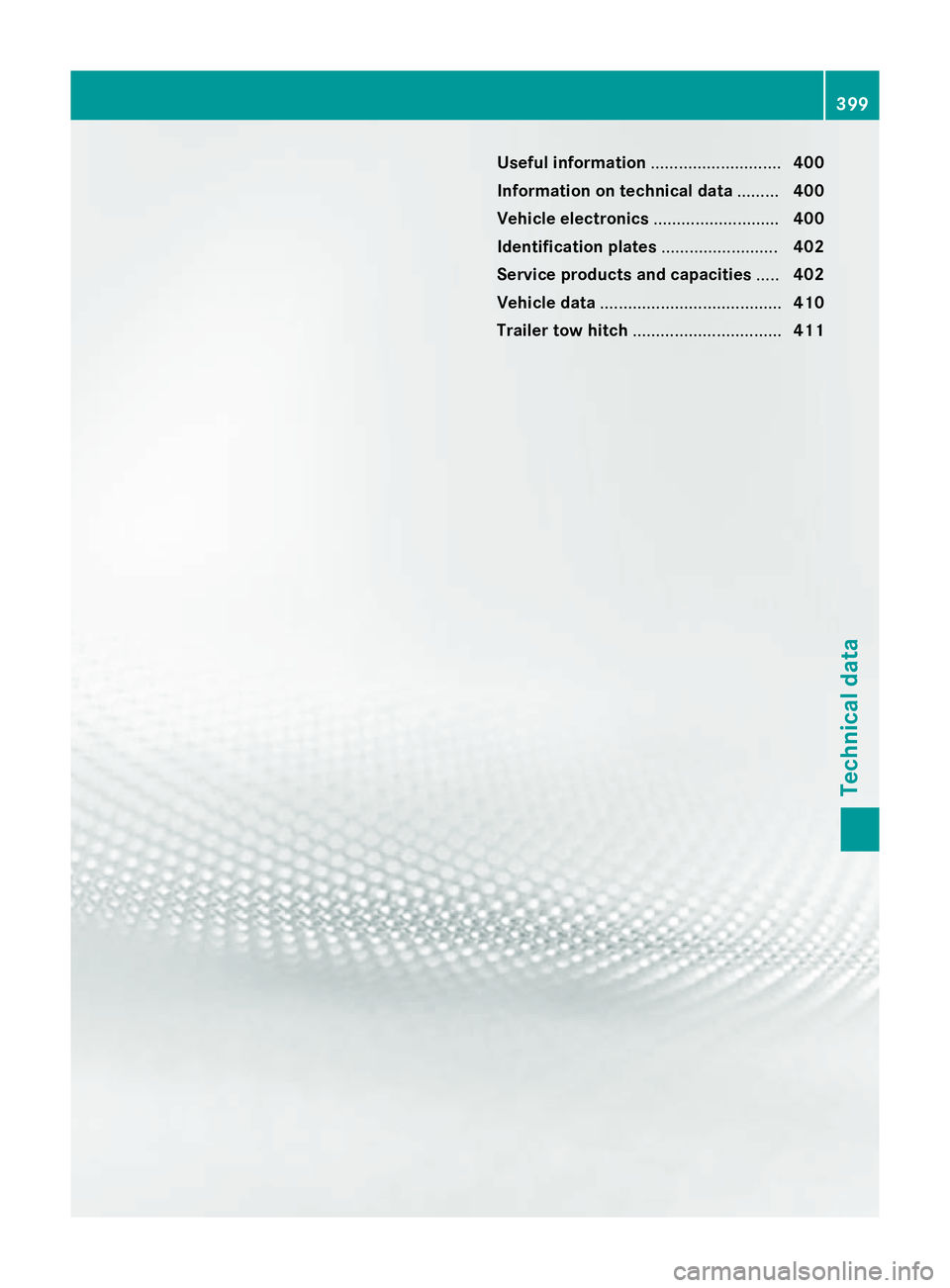
Useful information
............................400
Information on technical data .........400
Vehicle electronics ...........................400
Identification plates .........................402
Service products and capacities .....402
Vehicle data ....................................... 410
Trailer tow hitch ................................ 411 399Technical data
Page 405 of 421
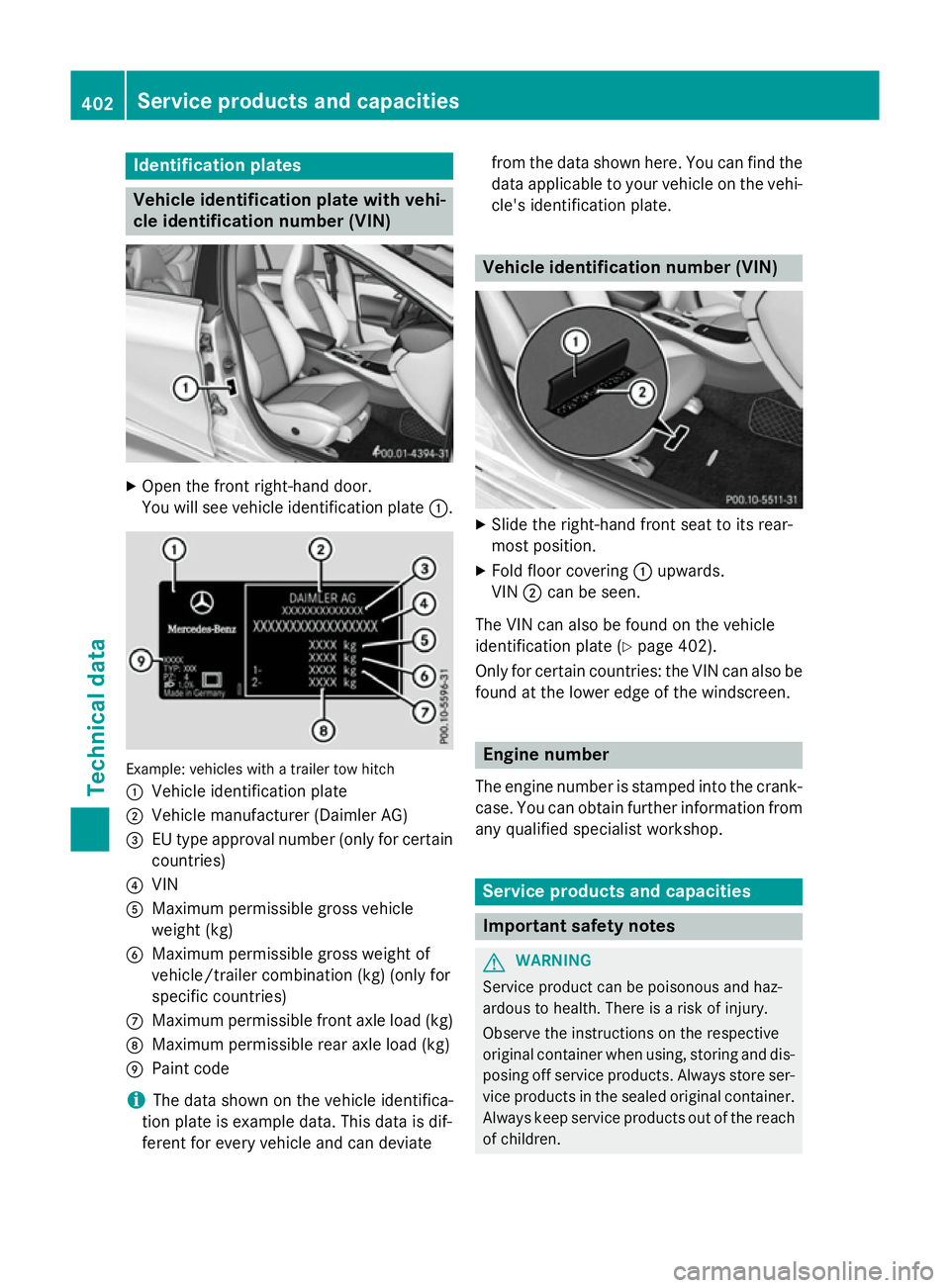
Identification plates
Vehicle identification plate with vehi-
cle identification number (VIN) X
Open the front right-hand door.
You will see vehicle identification plate :.Example: vehicles with a trailer tow hitch
: Vehicle identification plate
; Vehicle manufacturer (Daimler AG)
= EU type approval number (only for certain
countries)
? VIN
A Maximum permissible gross vehicle
weight (kg)
B Maximum permissible gross weight of
vehicle/trailer combination (kg) (only for
specific countries)
C Maximum permissible front axle load (kg)
D Maximum permissible rear axle load (kg)
E Paint code
i The data shown on the vehicle identifica-
tion plate is example data. This data is dif-
ferent for every vehicle and can deviate from the data shown here. You can find the
data applicable to your vehicle on the vehi- cle's identification plate. Vehicle identification number (VIN)
X
Slide the right-hand front seat to its rear-
most position.
X Fold floor covering :upwards.
VIN ;can be seen.
The VIN can also be found on the vehicle
identification plate (Y page 402).
Only for certain countries: the VIN can also be
found at the lower edge of the windscreen. Engine number
The engine number is stamped into the crank-
case. You can obtain further information from any qualified specialist workshop. Service products and capacities
Important safety notes
G
WARNING
Service product can be poisonous and haz-
ardous to health. There is a risk of injury.
Observe the instructions on the respective
original container when using, storing and dis- posing off service products. Always store ser-
vice products in the sealed original container. Always keep service products out of the reach
of children. 402
Service products and capacitiesTechnical data
Page 409 of 421
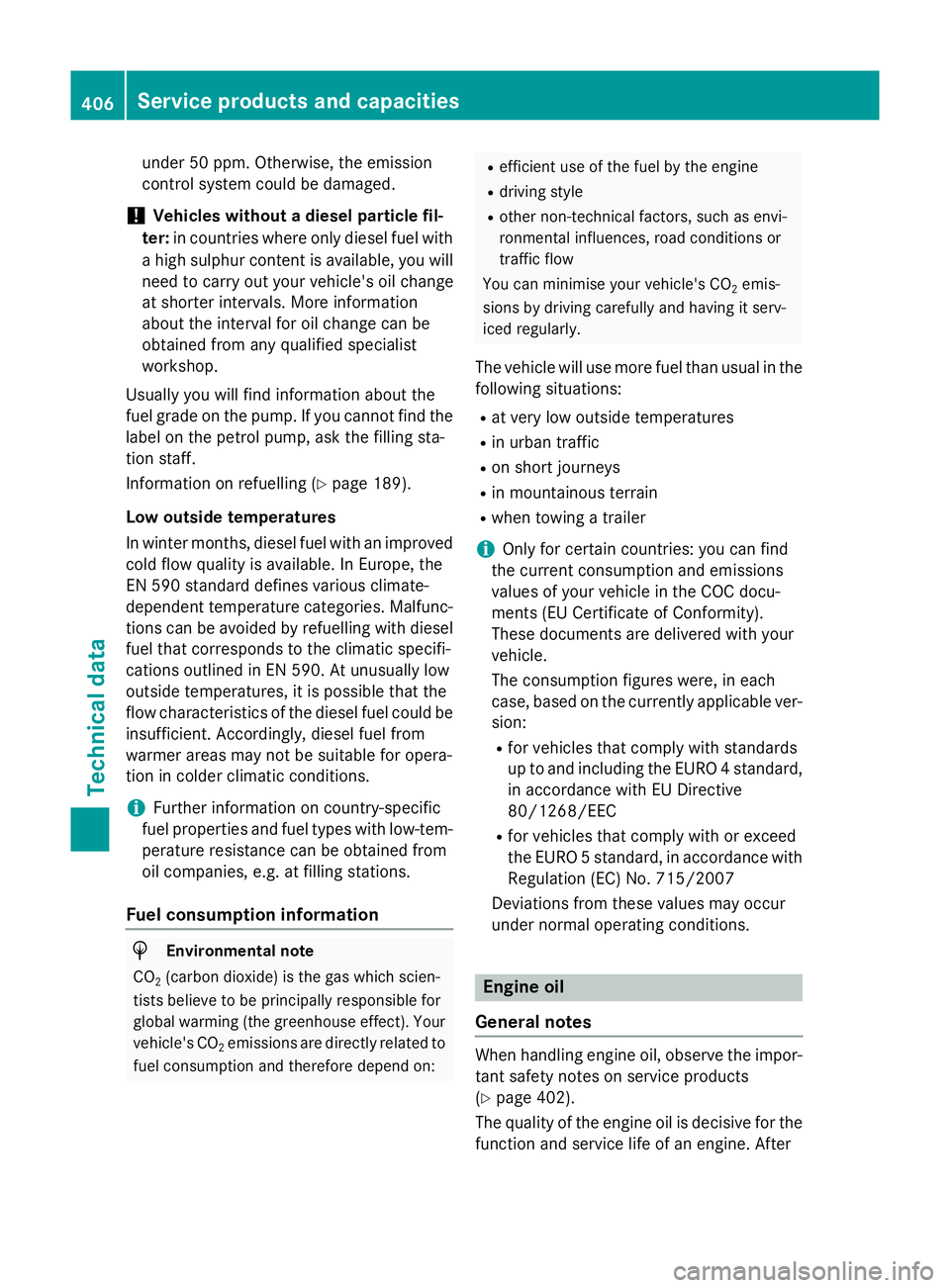
under 50 ppm. Otherwise, the emission
control system could be damaged.
! Vehicles without a diesel particle fil-
ter: in countries where only diesel fuel with
a high sulphur content is available, you will need to carry out your vehicle's oil change
at shorter intervals. More information
about the interval for oil change can be
obtained from any qualified specialist
workshop.
Usually you will find information about the
fuel grade on the pump. If you cannot find the label on the petrol pump, ask the filling sta-
tion staff.
Information on refuelling (Y page 189).
Low outside temperatures
In winter months, diesel fuel with an improved cold flow quality is available. In Europe, the
EN 590 standard defines various climate-
dependent temperature categories. Malfunc-
tions can be avoided by refuelling with diesel
fuel that corresponds to the climatic specifi-
cations outlined in EN 590. At unusually low
outside temperatures, it is possible that the
flow characteristics of the diesel fuel could be insufficient. Accordingly, diesel fuel from
warmer areas may not be suitable for opera-
tion in colder climatic conditions.
i Further information on country-specific
fuel properties and fuel types with low-tem-
perature resistance can be obtained from
oil companies, e.g. at filling stations.
Fuel consumption information H
Environmental note
CO 2(carbon dioxide) is the gas which scien-
tists believe to be principally responsible for
global warming (the greenhouse effect). Your
vehicle's CO 2emissions are directly related to
fuel consumption and therefore depend on: R
efficient use of the fuel by the engine
R driving style
R other non-technical factors, such as envi-
ronmental influences, road conditions or
traffic flow
You can minimise your vehicle's CO 2emis-
sions by driving carefully and having it serv-
iced regularly.
The vehicle will use more fuel than usual in the following situations:
R at very low outside temperatures
R in urban traffic
R on short journeys
R in mountainous terrain
R when towing a trailer
i Only for certain countries: you can find
the current consumption and emissions
values of your vehicle in the COC docu-
ments (EU Certificate of Conformity).
These documents are delivered with your
vehicle.
The consumption figures were, in each
case, based on the currently applicable ver- sion:
R for vehicles that comply with standards
up to and including the EURO 4 standard,
in accordance with EU Directive
80/1268/EEC
R for vehicles that comply with or exceed
the EURO 5 standard, in accordance with
Regulation (EC) No. 715/2007
Deviations from these values may occur
under normal operating conditions. Engine oil
General notes When handling engine oil, observe the impor-
tant safety notes on service products
(Y page 402).
The quality of the engine oil is decisive for the
function and service life of an engine. After 406
Service products and capacitiesTechnical data
Page 414 of 421
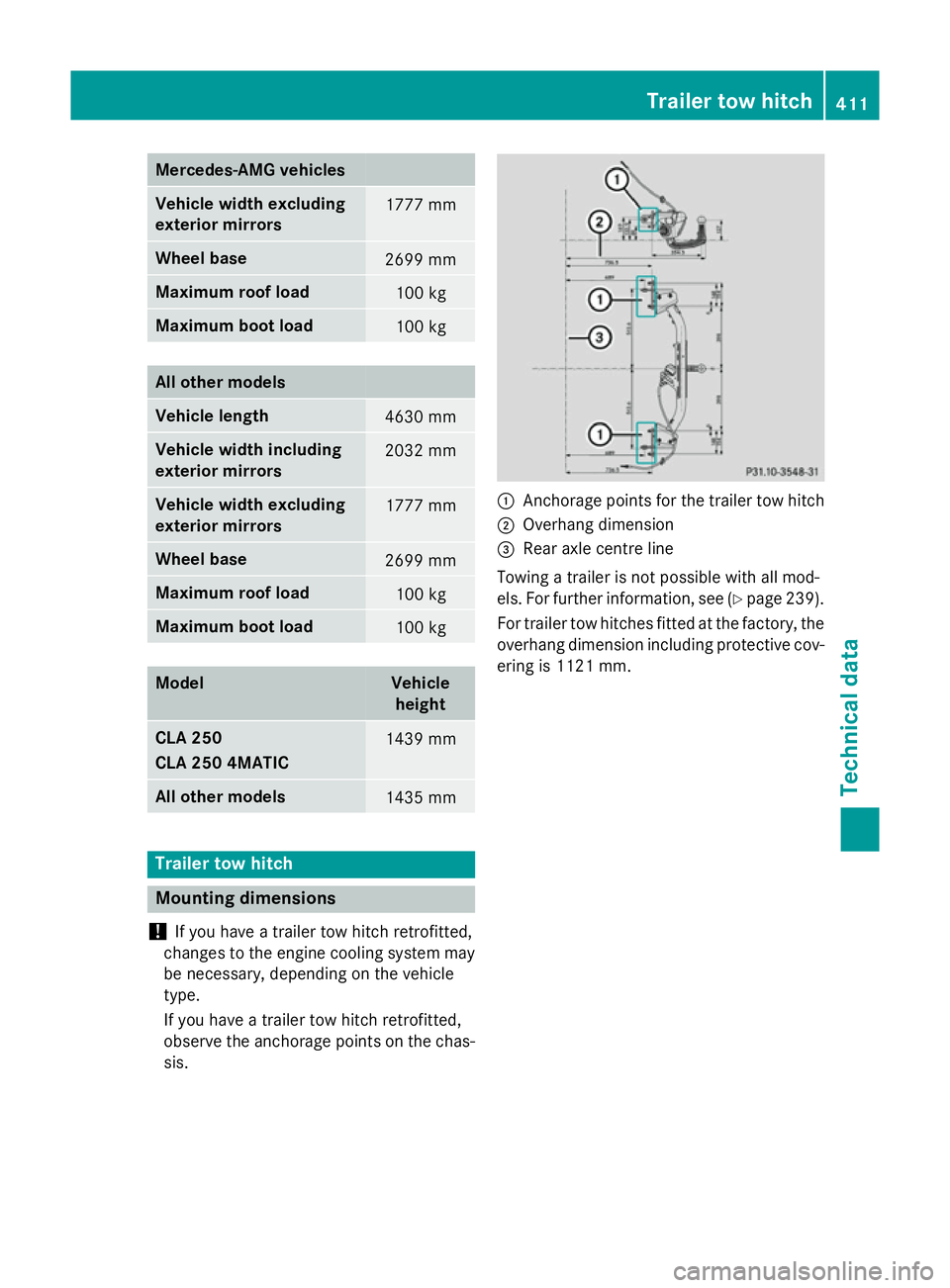
Mercedes-AMG vehicles
Vehicle width excluding
exterior mirrors
1777 mm
Wheel base
2699 mm
Maximum roof load
100 kg
Maximum boot load
100 kg
All other models
Vehicle length
4630 mm
Vehicle width including
exterior mirrors
2032 mm
Vehicle width excluding
exterior mirrors
1777 mm
Wheel base
2699 mm
Maximum roof load
100 kg
Maximum boot load
100 kg
Model Vehicle
height CLA 250
CLA 250 4MATIC
1439 mm
All other models
1435 mm
Trailer tow hitch
Mounting dimensions
! If you have a trailer tow hitch retrofitted,
changes to the engine cooling system may
be necessary, depending on the vehicle
type.
If you have a trailer tow hitch retrofitted,
observe the anchorage points on the chas- sis. :
Anchorage points for the trailer tow hitch
; Overhang dimension
= Rear axle centre line
Towing a trailer is not possible with all mod-
els. For further information, see (Y page 239).
For trailer tow hitches fitted at the factory, the
overhang dimension including protective cov- ering is 1121 mm. Trailer tow hitch
411Technical data Z
Page 415 of 421
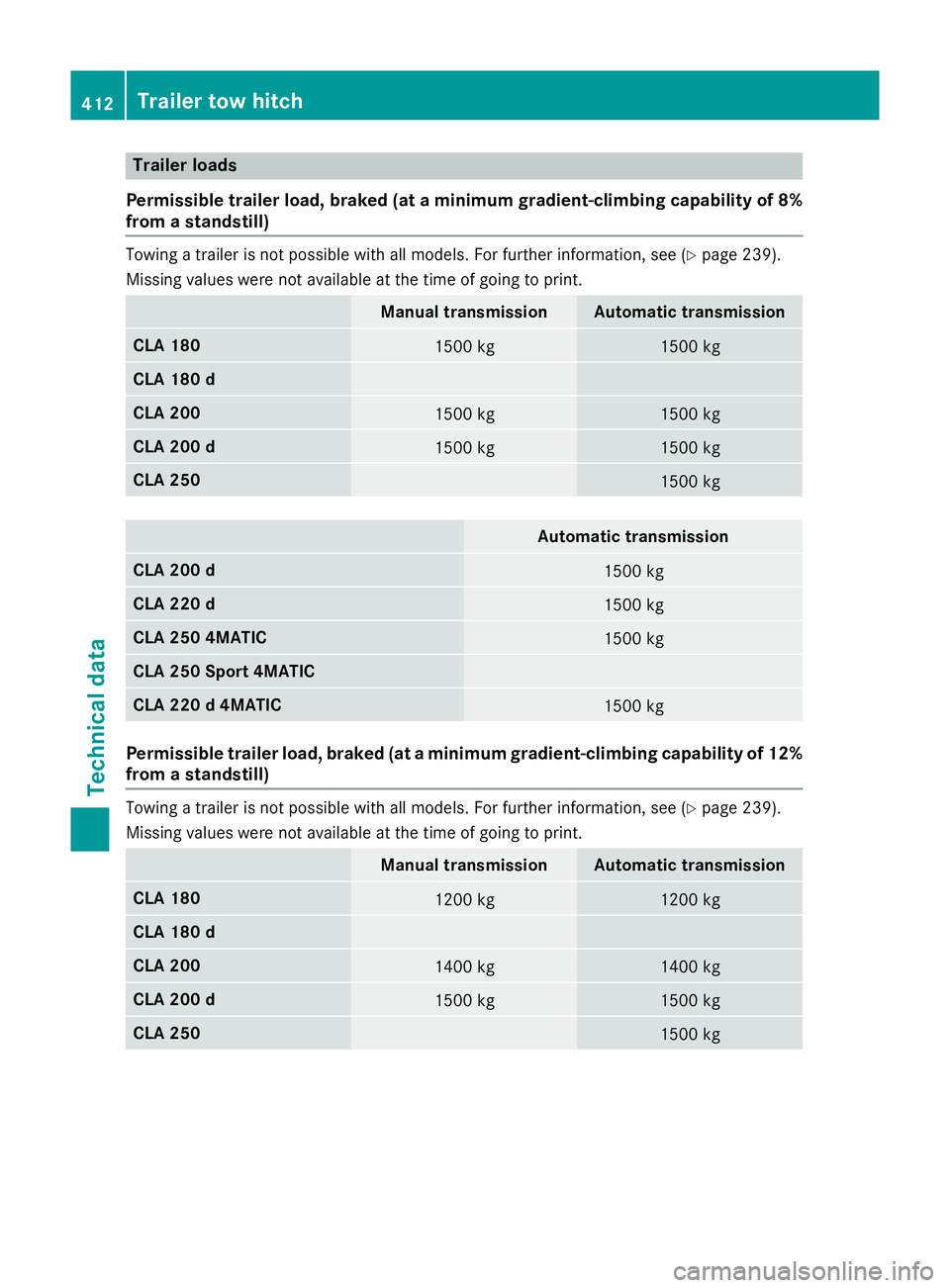
Trailer loads
Permissible trailer load, braked (at a minimum gradient-climbing capability of 8%
from a standstill) Towing a trailer is not possible with all models. For further information, see (Y
page 239).
Missing values were not available at the time of going to print. Manual transmission Automatic transmission
CLA 180
1500 kg 1500 kg
CLA 180 d
CLA 200
1500 kg 1500 kg
CLA 200 d
1500 kg 1500 kg
CLA 250
1500 kg
Automatic transmission
CLA 200 d
1500 kg
CLA 220 d
1500 kg
CLA 250 4MATIC
1500 kg
CLA 250 Sport 4MATIC
CLA 220 d 4MATIC
1500 kg
Permissible trailer load, braked (at a minimum gradient-climbing capability of 12%
from a standstill) Towing a trailer is not possible with all models. For further information, see (Y
page 239).
Missing values were not available at the time of going to print. Manual transmission Automatic transmission
CLA 180
1200 kg 1200 kg
CLA 180 d
CLA 200
1400 kg 1400 kg
CLA 200 d
1500 kg 1500 kg
CLA 250
1500 kg412
Trailer tow hitchTechnical data
Page 416 of 421
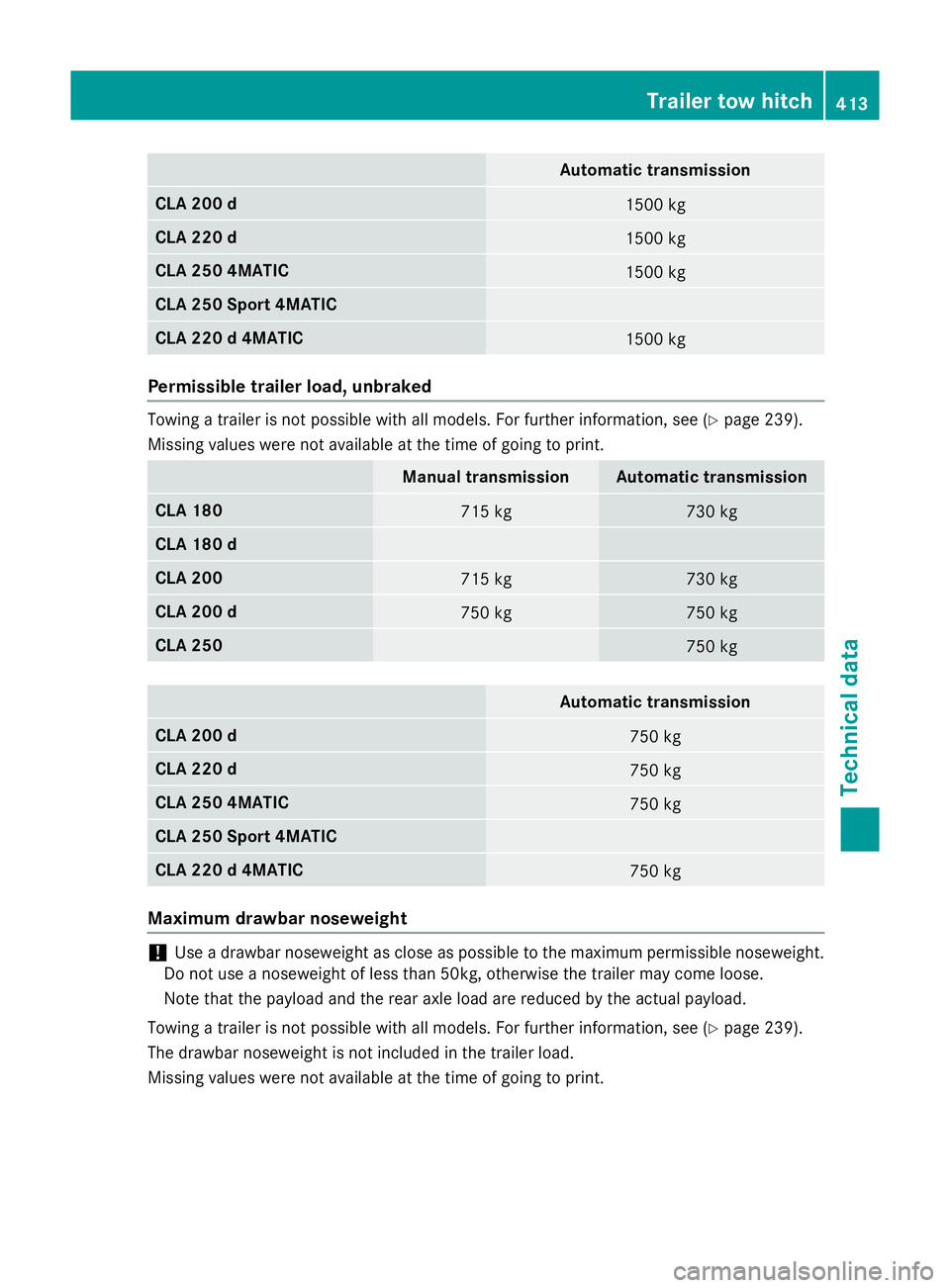
Automatic transmission
CLA 200 d
1500 kg
CLA 220 d
1500 kg
CLA 250 4MATIC
1500 kg
CLA 250 Sport 4MATIC
CLA 220 d 4MATIC
1500 kg
Permissible trailer load, unbraked
Towing a trailer is not possible with all models. For further information, see (Y
page 239).
Missing values were not available at the time of going to print. Manual transmission Automatic transmission
CLA 180
715 kg 730 kg
CLA 180 d
CLA 200
715 kg 730 kg
CLA 200 d
750 kg 750 kg
CLA 250
750 kg
Automatic transmission
CLA 200 d
750 kg
CLA 220 d
750 kg
CLA 250 4MATIC
750 kg
CLA 250 Sport 4MATIC
CLA 220 d 4MATIC
750 kg
Maximum drawbar noseweight
!
Use a drawbar noseweight as close as possible to the maximum permissible noseweight.
Do not use a noseweight of less than 50kg, otherwise the trailer may come loose.
Note that the payload and the rear axle load are reduced by the actual payload.
Towing a trailer is not possible with all models. For further information, see (Y page 239).
The drawbar noseweight is not included in the trailer load.
Missing values were not available at the time of going to print. Trailer tow hitch
413Technical data Z
Page 417 of 421
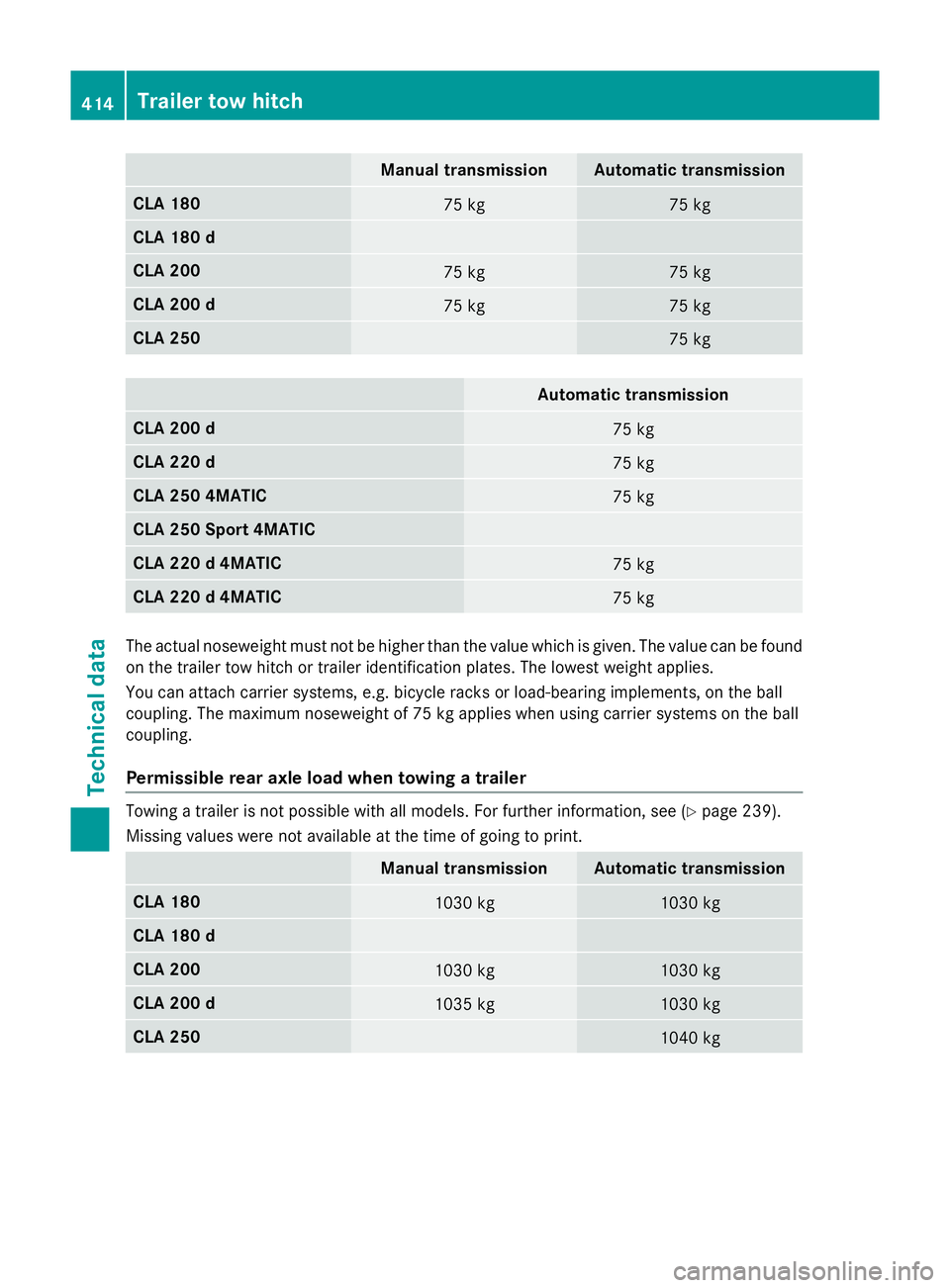
Manual transmission Automatic transmission
CLA 180
75 kg 75 kg
CLA 180 d
CLA 200
75 kg 75 kg
CLA 200 d
75 kg 75 kg
CLA 250
75 kg
Automatic transmission
CLA 200 d
75 kg
CLA 220 d
75 kg
CLA 250 4MATIC
75 kg
CLA 250 Sport 4MATIC
CLA 220 d 4MATIC
75 kg
CLA 220 d 4MATIC
75 kg
The actual noseweight must not be higher than the value which is given. The value can be found
on the trailer tow hitch or trailer identification plates. The lowest weight applies.
You can attach carrier systems, e.g. bicycle racks or load-bearing implements, on the ball
coupling. The maximum noseweight of 75 kg applies when using carrier systems on the ball
coupling.
Permissible rear axle load when towing a trailer Towing a trailer is not possible with all models. For further information, see (Y
page 239).
Missing values were not available at the time of going to print. Manual transmission Automatic transmission
CLA 180
1030 kg 1030 kg
CLA 180 d
CLA 200
1030 kg 1030 kg
CLA 200 d
1035 kg 1030 kg
CLA 250
1040 kg414
Trailer tow hitchTechnical data